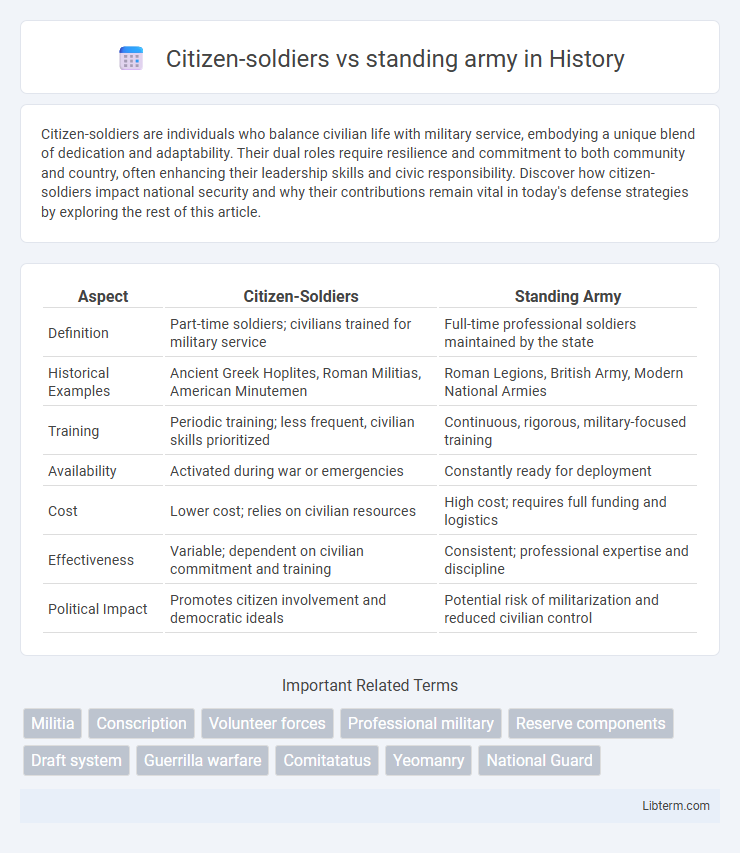Citizen-soldiers are individuals who balance civilian life with military service, embodying a unique blend of dedication and adaptability. Their dual roles require resilience and commitment to both community and country, often enhancing their leadership skills and civic responsibility. Discover how citizen-soldiers impact national security and why their contributions remain vital in today's defense strategies by exploring the rest of this article.
Table of Comparison
| Aspect | Citizen-Soldiers | Standing Army |
|---|---|---|
| Definition | Part-time soldiers; civilians trained for military service | Full-time professional soldiers maintained by the state |
| Historical Examples | Ancient Greek Hoplites, Roman Militias, American Minutemen | Roman Legions, British Army, Modern National Armies |
| Training | Periodic training; less frequent, civilian skills prioritized | Continuous, rigorous, military-focused training |
| Availability | Activated during war or emergencies | Constantly ready for deployment |
| Cost | Lower cost; relies on civilian resources | High cost; requires full funding and logistics |
| Effectiveness | Variable; dependent on civilian commitment and training | Consistent; professional expertise and discipline |
| Political Impact | Promotes citizen involvement and democratic ideals | Potential risk of militarization and reduced civilian control |
Defining Citizen-Soldiers and Standing Armies
Citizen-soldiers are civilians trained to serve in the military during emergencies, embodying the principle of a well-regulated militia supporting national defense without maintaining a full-time professional force. Standing armies consist of permanent, full-time soldiers maintained by a government, offering continuous readiness and specialized military expertise but often raising concerns about potential misuse of power. The distinction lies in the balance between civilian involvement and professional military organization, influencing defense strategies and civil-military relations.
Historical Origins and Evolution
Citizen-soldiers trace their origins to ancient militias where civilians temporarily took up arms to defend their communities, exemplified by early Greco-Roman hoplites and colonial militias in Revolutionary America. The standing army system evolved alongside centralized states during the early modern period, with Europe's professional forces like the Prussian army shaping modern military structures. Over time, the shift from citizen-soldiers to standing armies reflected changes in warfare complexity, state power, and societal organization.
Recruitment and Composition Differences
Citizen-soldiers typically consist of part-time volunteers drawn from the civilian population, emphasizing a temporary commitment and local defense responsibilities, whereas standing armies are composed of full-time professional soldiers recruited through systematic enlistment processes. Citizen-soldiers often bring diverse civilian skills and maintain connections to their communities, while standing armies prioritize specialized military training and hierarchical organization for sustained operational readiness. Recruitment in citizen-soldier models relies heavily on civic duty and militia traditions, contrasting with the standing army's structured career paths and government-facilitated conscription or volunteer programs.
Training and Readiness Levels
Citizen-soldiers undergo periodic training that emphasizes rapid skill reacquisition and adaptability, often balancing military duties with civilian careers, resulting in variable readiness levels compared to full-time soldiers. Standing armies maintain continuous, intensive training regimens that ensure high proficiency and immediate operational readiness. This structured and consistent preparation in standing armies typically leads to superior tactical performance during rapid deployment scenarios.
Role in National Defense Strategies
Citizen-soldiers play a crucial role in national defense strategies by providing a flexible, cost-effective reserve force that can be rapidly mobilized during emergencies, enhancing homeland security and resilience. Standing armies offer continuous readiness, professional expertise, and sustained military presence essential for deterrence, rapid response, and international operations. Integrating citizen-soldiers with standing armies balances the benefits of volunteer professionalism with the broad-based defense capacity vital for comprehensive national security.
Impact on Civil-Military Relations
Citizen-soldiers typically strengthen civil-military relations by fostering a sense of shared responsibility and democratic control over the military, as they are drawn from the civilian population and remain closely connected to society. In contrast, a standing army often risks creating a professionalized military class that can become detached from civilian oversight, potentially leading to mistrust or tensions between military leaders and civilian authorities. The balance between these forces shapes the degree of civilian control, accountability, and integration of military perspectives within broader governance structures.
Costs and Economic Considerations
Citizen-soldiers generally incur lower costs compared to a standing army, as they require less funding for full-time salaries, benefits, and long-term pensions. Economically, relying on a militia allows governments to allocate resources to other sectors by minimizing continuous military expenditures. However, sudden mobilization of citizen-soldiers may lead to increased short-term expenses and potential productivity losses in civilian industries.
Flexibility and Mobilization Speed
Citizen-soldiers provide unparalleled flexibility by rapidly assembling in response to immediate threats, leveraging local knowledge and community ties for effective mobilization. Standing armies maintain constant readiness with trained personnel but may have slower deployment times due to centralized command and logistics. The ability of citizen-soldiers to quickly transition from civilian roles to combat positions allows for dynamic responses in diverse environments, unlike the more rigid structure of standing armies.
Influence on Democracy and Governance
Citizen-soldiers, often volunteers drawn from the general population, promote democratic governance by fostering greater civilian oversight and connection between military forces and society. In contrast, a standing army, maintained as a permanent, professional force, can centralize power and potentially reduce transparency, posing challenges to democratic accountability. The balance between these forces influences the distribution of power within a state, impacting civil-military relations and the protection of democratic institutions.
Modern Examples and Contemporary Debates
Citizen-soldiers remain a vital component of national defense in countries like Israel, where mandatory service integrates civilians into military roles, contrasting with the United States' reliance on a professional standing army. Contemporary debates revolve around balancing the cost-effectiveness and democratic engagement of citizen-soldiers against the specialized skills and rapid deployment capabilities of standing armies. Modern hybrid forces, combining conscripts and professionals, reflect an evolving military strategy addressing both national security needs and societal resilience.
Citizen-soldiers Infographic

 libterm.com
libterm.com